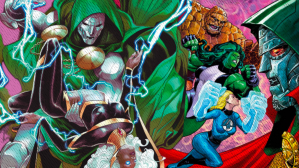
“World War Hulk” is better than I remembered it being. It still has one big obvious glaring problem that I’ll get to that later in this review. First, I want to cover all the cool and glorious stuff.
Videos by ComicBook.com
It’s a book that, for me, is a better book 11 years later and removed from much of the surrounding context of its original publication. (Take it away from being Yet Another Crossover Event between crossover events, for starters.)
The Background
For those coming in late, the Marvel Illuminati decided, for the sake of the earth and Bruce Banner, himself, to ship the Hulk out into outer space. Jam him in a ship and send him far off into space.
Seemed like a good plan at the time.
Actually, no, everyone knew it was a dumb idea at the time because everyone knew that would only be the first act of a bigger story.
And so Greg Pak ran with it, giving us Hulk’s adventures in space, on a planet where he crash lands, finds love, and loses it all.

That’s when he decides to return to earth to get his revenge on the Illuminati: Reed Richards, Black Bolt, Doctor Strange, and Tony Stark. (I forget my continuity now. Was Namor and Professor X dead at this point?)
Publishing Plans
Yes, Marvel stuck to their playbook and released a checklist full of books you might want to read to get “the whole story.” On the bright side, I didn’t need a single one of those issues to understand what was going on in the five issue “World War Hulk” series.
But, man, did they do the whole cash-in thing with this, launching four or five mini-series that ran alongside it and tied in with it. That goes along with the other tie-ins with issues from, of course, the then-current “Hulk” series, and some “Avengers” books, et. al.
It wasn’t overwhelming, but it was a lot of books to buy if you wanted it all.
Hulk Smash

The one thing they did right was to make this a five issue mini-series where every issue was double-sized. That felt great. Greg Pak had plenty of space to tell a big chunk of story in each issue without having to worry about crowding out the large action pieces this book was created to deliver. You want to give John Romita Jr. that kind of room.
And that’s really where I enjoyed this series the most. It’s not trying to be anything subversive or meaningful or deep. This is about the Strongest One There Is returning to earth for revenge, and the big huge fight scenes that are the result of that. If you constrained those scenes in a bunch of smaller panels, you’d have had a dull book.
Romita Jr. had all the room in the world in this series to draw lots of double-page spreads, single panels that take up most of a page, and entire sequences of fisticuffs brimming with energy and laced with special lighting and lettering effects.
They knew what they had with this book, and they gave it the room to help it shine. It’s the smartest move they could make.

Chris Eliopoulos’ lettering matches the size and fierceness of the action. It doesn’t dominate the page in the way a John Workman job might. I like the way Eliopoulos blends in here, with lively and descriptive shapes to all his lettering. It matches every scene.
But the star of this book is Romita Jr.’s artwork, well inked by the legendary Klaus Janson. It is big and bold and filled with the kind of mammoth energy a book like this deserves. While at it’s core, this is a book about a Hulk who feels betrayed by his friends and who’s grown up a lot during his absence and wants to teach them all a lesson, this is mostly a book about epic battles in New York City that tear apart both buildings and superheroes. It’s no holds barred gamma powered mania.
That’s what this book is — an excuse for an increasingly crazier and bigger series of fights. It’s a superhero comic. Enjoy it for the spectacle. They do it very well here. How can you go wrong with Hulk rampaging through New York City?
On the Other Hand

…it’s the Sentry. I’m sorry, but I’m still in the Anti-Sentry camp. It was a cute gimmick for one mini-series, but everything past that has been a waste of space.
In this book, he’s the gun Chekhov puts up on the wall in the first act. We know the heroes are saving him for the last ditch effort to bring down the Hulk. So we wait four more issues for the situation to get bad enough that he’s needed. Everything in that time span feels like it’s just marking time until we get to “The Big Event” with The Sentry.
In Pak and Romita’s defense, it is a somewhat satisfying bit of business when he does show up to fight. After four issues waiting for Sentry to wake up and smell the coffee, he bursts onto the scene and the fists immediately fly with some amount of fury. It’s charged and bombastic. The scenes shimmer wth energy. But it’s still the mopey Sentry coming in to save the day.
And then things twist around again when the sure thing isn’t so sure, after all.
Third acts for these types of books are tough to come by. I think Pak found a satisfying one. It pays off on all the mini-series’ promises, provides a definitive ending, and leaves the heroes in something of a bad state. In other words, it sets up lots of material to be handled in other titles afterwards.
On the other hand, it’s another event filled with heroes fighting heroes that filled the landscape in a post-Civil War world.
But HULK SMASH!
PipelineComics.com|| Twitter || Instagram || E-mail || YouTube





